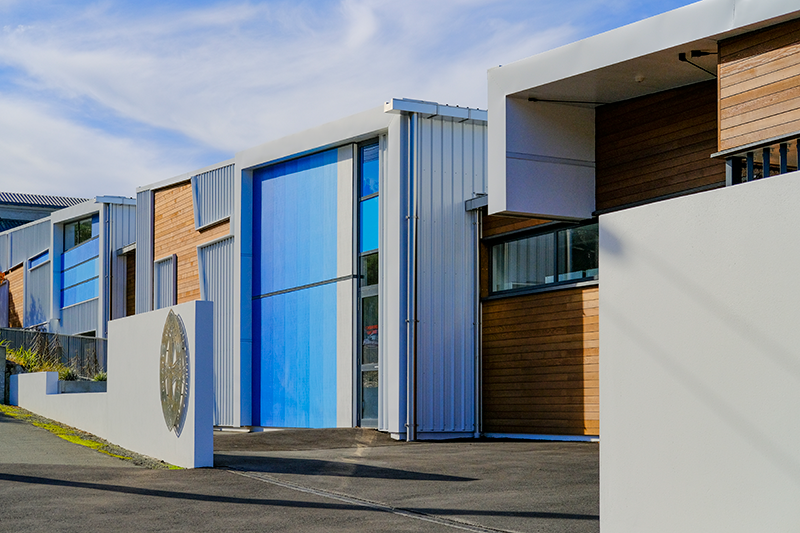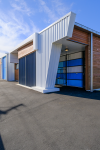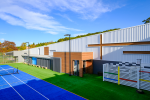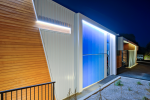St Hilda's Collegiate Visual & Performing Arts Centre

Designing a Visual and Performing Arts Centre with its diverse demands is a complicated task but the challenges are amplified when it fronts a street in an inner-city residential area.
When Cameron Grindlay, of Dwelling Architectural Design, started assembling the design brief for the new Visual and Performing Arts Centre at St Hilda’s Collegiate School in Dunedin there were many important elements to consider.
The centre needed ample, suitable and versatile spaces for dance, drama, live performance, photography, and visual art, but Cameron also had to have consideration for its visual impact in the neighbourhood, minimising the noise generated, and taking into account the privacy of those neighbours and the students using the spaces.
The underlying design narrative was proposed by the Head of the Art Department based on a waka huia. A waka huia is a treasure box, used by Maori to hold precious adornments. In this case the staff, students and the work they create is the precious treasure held within the building.
The long, raked building is broken into three sections for relief, with horizontal cedar cladding and blue painted plywood “carvings” inlaid on the vertical longrun ribbed cladding, providing adornment to the waka huia.
Ray Ferguson, of Ray Ferguson Roofing Ltd, says to execute the three sections and the carvings, “the flashing detail was very labour intensive. It was important to get the measurements correct to achieve a high standard of workmanship”.
“Some flashings had to fit over and under timber work. The builder gave me the points of reference where he was going to place the timber.”
Rays says that because the detailing of the cladding was so intricate, he coordinated throughout with the builder and architect.
“I made up small patterns for the flashings using strips of ColorSteel to ensure the flashing would fit correctly before having them made due to the amount of folds.”
He adds, “The large flashings on the front of the building were a challenge due to their size. They had to be lifted off the truck and taken up to the roof manually without them flexing and getting damaged.”
The 780sqm building rises from a single storey at the entrance to a double-height north-facing but windowless performance space with lighting gantry.
To reduce the building’s height and impact from the road, the north end of the building has been excavated into the site. Services to the roof are restricted, maintaining the clean lines of the building.
The long, slender form is positioned along the edge of the site, providing privacy and safety from the road while also sheltering a new artificial turf tennis/netball court on the opposite side.
The white longrun roofing and cladding and the cedar cladding complement the surrounding palette in the residential area. The white roofing cladding also greatly reduces the heat loading on the building.
Quality acoustic design ensures that there is excellent sound in the performance spaces, reduced reverberation in classroom spaces and reduced sound to neighbours. This was achieved using acoustic and angled wall and ceiling panelling and double and triple linings and roof sarking.
Cameron also had to take into account that natural light into the Dance, Drama and Photography spaces needed to be minimised, while indirect, ambient natural light was beneficial for displaying visual art.
The performing spaces at the north have separate access to avoid thoroughfares. This also allows private functions (with kitchen) and performances without opening the rest of the building.
The main performance space can also be closed off and the smaller dance area made private for rehearsals.
The centre of the building has shared storage/services areas for space efficiency and to allow for collaborations in productions. A mezzanine floor contains costume storage/changing, light/sound booth and plant rooms.
Interiors are neutral and warm, providing a backdrop for but not competing with student creativity.
All products were compared to competitors for sustainability. Everything from manufacturing processes to a company’s environmental record were taken into account when selecting materials.
The building won the Architectural Designers of New Zealand (ADNZ) 2020 commercial/industrial award.
The judges were impressed that the building avoided the “predictable pitfalls” of being either overly flashy or boxy and anonymous.
They said, “The façade is broken into playful elements, inferring the syncopated rhythm of the different spaces and activities without descending into visual chaos. This is aided by the limited palette of cladding materials with vertical corrugated long run combined with horizontal cedar echoing the vernacular materiality of the surrounding housing stock.”
Dwelling Architectural Design
The practice’s philosophy is that. “Designing is part of the process of creating, and it should be a process that is enjoyed by all – from the client to the sub-contractor. It is a chance to dream and the end result should be something that everyone is proud of.
“Design needs to be sustainable, individual and tailored for the site. Thought needs to be given to materials, sun, views, prevailing wind, budget and how the client lives in order to make the final outcome relevant.
“Design needs to be thorough with attention paid to detail. This is the art of communicating through drawings. Time and attention paid at the start, pays dividends during the build. Design decisions need to be made early. It is strange but true that to make something look simple and elegant takes more time, thought and detail than making a cluttered form.
“Creating takes a team. For a build to be a successful, it takes teamwork from the client, the designer, consultants, the contractor and sub-contractors working towards a common goal. We are in this together and together we can come up with creative solutions. The job does not end when the design is complete but the designer needs to be involved until the end.
“That is Dwelling’s goal – creative, sustainable and thoughtful design, brought to life by a team that enjoys the process.”



